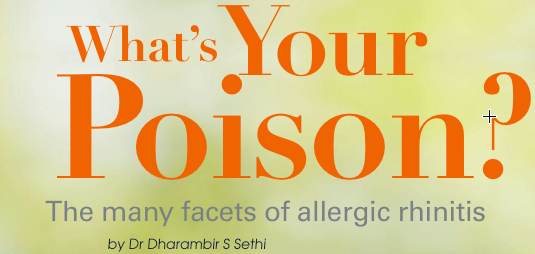Home / Allergy Services / Allergy Rhinitis
Allergy Rhinitis
Call +65 8125 3580
for 24 by 7 appointment
What is allergic rhinitis?
The term “allergic rhinitis” implies inflammation of the mucosal lining of the nasal. When this inflammation is primarily caused by an “allergen” to which one is identified to be allergic to, the term allergic rhinitis is used. Allergic rhinitis is one of the commonest medical conditions encountered globally. It affects 10-40% of the population in industrialised countries. The incidence of allergic rhinitis in US is about 17% of the population and in Singapore a study showed the incidence to be around 13%. The economic impact of allergic rhinitis in the United States is estimated to be roughly 8 billion dollars annually. The time lost from work is estimated at 10 million days a year and for children the time lost from missing school is 2 million days a year.
How does allergy develop For the patient to develop allergy, the allergen must enter the body to produce symptoms. The most common portal of allergy is the respiratory route; in other words most of the times we inhale the allergens. Not surprisingly most symptoms caused by inhalant allergens occur in the respiratory tract.When an allergen, something that one is allergic to, enters the body it incites certain cells (B cells) of the immune system to produce antibodies specific to that particular allergen. These antibodies then bind to some other type of cells called the mast cells. This binding causes the mast cells to become “sensitised” to that particular allergen. When these sensitised mast cells come in contact with the allergen they liberate histamine and other chemical mediators responsible for the symptoms of allergy. This process is triggered when the allergen enters the body and binds to the specific antibodies already present on the surface of the mast cells. The process of liberating the histamine and other chemical mediators is called degranulation. The mast cells are located in the target organs of the body. Any part of the body can be the target organ but in most cases it is the upper and lower respiratory and the gastrointestinal system.
What parts of the body are involved in allergies?
The structure with which the public most commonly associates with allergy is the nose. But in actual fact, allergy may be the root cause of a wide variety of complaints presenting to a doctor in ENT practice. Unknown to the patient and sometimes the physician, allergy may be lurking in the back ground as the great masquerade for a wide variety of presenting symptoms. A reasonable axiom for the ENT doctor might be “when all is not going well, give a thought to allergy” Allergy can affect any part of the body. In the nose allergy causes inflammation of the nasal passages and is usually associated with runny nose, sneezing, itch and blocked nose. When inflammation of the nasal mucosa is caused by offending allergens the term “Allergic Rhinitis” is used. Allergic Rhinitis may be seasonal or perennial. In seasonal countries the commonest cause of allergic rhinitis is pollen. Perennial allergy that persists throughout is more common and caused by dust and several other allergens. It is perennial allergy that is seen in Singapore.In the ears allergy may be the cause of “otitis externa” i.e. chronic inflammation of the pinna or the ear canals. Allergy may also cause “glue ear”, recurrent ear infections, barotrauma and Eustachian tube dysfunction. Allergy has been even implicated as the possible cause of Meniere’s disease where the patient suffers from episodes of fluctuating hearing loss, tinnitus or vertigo especially if the patient is known to have allergic problems of other types.The throat is not as commonly involved as the nose and ears, but allergy can be the cause of chronic sore throat in some patients. The sinuses may be affected as well. In fact most patients with allergic rhinitis present with the complaint “I have this sinus!” There is also a high association between allergic rhinitis, asthma and chronic sinus condition.
What are the common types of allergens?
For practical purposes, the inhalant allergens are generally divided into two types: perennial and seasonal. Perennial offenders are present throughout the year. These include house dust, which has been considered as the universal antigen. The best known antigen present in house dust is the mite Dermatophagoides. The species D. pteronyssinus and D. farinae are the commonest. Other allergens include insects such cockroach and cricket. Epidermal allergens include animal hair of furry animals where cats and dogs top the list. The dander and other allergens produced by the furry animals are light and become an intimate part of the drapes, carpets and other décor. These allergens are everywhere. Mould allergy is worldwide and at all seasons. Millions of mould spores are present in the air at all times and form a blanket extending upward from earth to a height of 2 miles!! Moisture and decay promote mould growth. Area around plumbing and water pipes is subject to condensation and accumulate major amounts of mould growth. A prolific source of indoor mould is found in piles of old newspaper. There are currently more than 80,000 species of mould identified!! Food Allergy includes allergy to milk, wheat, corn, yeast, egg and soy represent the largest group.
What are the symptoms of allergy?
Inhalant allergy may vary in its manifestation depending on the type of allergen. In perennial allergic rhinitis the signs and symptoms may be indistinguishable from the common cold. The patient often complains of a “cold that never goes away”. Others complain of intermittent or persistent nasal stuffiness and post nasal drip where the mucus thick yellow and sticky. Food allergy is even more insidious. Its manifestations have been well described by the term “many syndrome” i.e. many symptoms, many organ symptoms, many physicians, many tests, many failures. It can mimic a wide variety of medical conditions. As a result of long standing nasal obstruction and itchiness some patient may develop typical facial characteristics. These include deep discoloration involving the lower eyelids termed “allergic shiners” or semi-horizontal crecentric creases called “Denny’s lines”. As a result of chronic nasal itchiness some patients tend to use the palm of their hands to rub the tip of their nose. This is called the “allergic salute”. Inability to breathe through the nose patients resort to mouth breathing leading to something called “adenoid facies” which has been well described.
How is allergy diagnosed?
The presumptive diagnosis is usually made from history and physical examination.
Skin Prick Test: Among the tests to confirm the diagnosis of allergy the skin prick test to is quite popular. This test is inexpensive and can be safely performed in the clinic. The skin prick test is very sensitive but is however, subject to a variety of external influences. Antihistamines, several tranquilizers, cough medications and drugs with similar actions may depress skin activity making readings unreliable. The skin tests can also be time consuming. Radioallergosorbent Test (RAST): For patients not suitable for skin prick test a blood test is available. This is called the Radioallergosorbent Test (RAST). Each antigen produces an antibody specific to the antigen. This test measures the serum level of that specific antibody. This test overcomes or entirely eliminates the variability of the skin tests. It saves time and causes less discomfort to the patient. The cost however, may be a concern as it can be expensive to test a whole panel of allergens. It is also not as sensitive as skin prick test. In summary, two approaches are currently in use, one using the patient’s skin response as a guide and the other which depends on the laboratory analysis of the patient’s blood. Both provide basically the same information and both have their advantages and disadvantages. The skin test is more sensitive but subject to variable of skin reactivity as well as the influence of certain medications on skin responses. It is also more uncomfortable and time consuming to the patient. The RAST is more specific, not influenced by external influences but is not as sensitive. It is also more expensive.
What is the treatment for allergic rhinitis?
Once the allergen/s is/are identified some definitive form of therapy is planned. In most cases more than one approach will be needed before the patient reaches the maximal benefit. Treatment includes environmental control, pharmacotherapy, and immunotherapy. Ideally, allergy should be controlled by elimination of the offenders. Inhalant allergens consist of pollen (in seasonal countries), moulds and various members of the dust group including animal dander. Unfortunately elimination of these from the environment if far from easy. Pollen allergy is not common in Singapore but dust, mould and animal dander is abundant.
Medications: includes antihistamines, decongestants and steroids. Antihistamines have been in general use since the 1940s. All antihistamines have much in common because their basic mode of action is similar. Chemically, they compete with histamine for attachment sites on the target organs. Antihistamines function best when administered before allergen exposure. Almost all antihistamines tend to be sedative in nature, therefore operating machinery and driving a vehicle may be dangerous while on antihistamines. The degree of sedation produced by various antihistamines varies considerably from one to another. In recent years non-sedating newer antihistamines have been introduced in the markets that purportedly have no sedating effect. This sedative effect may vary from person to person. It is rare for antihistamine treatment alone to be able to handle persistent severe allergic problems and is often combined with decongestants to increase their range of effectiveness. Patients tend to develop tolerance to antihistamines fairly rapidly. Changing to a different antihistamine in the same class is of little value. Changing classes may provide some extension in the duration of the relief but it will rarely be prolonged. It is also rare to have life long relief by the use of antihistamines.
Steroids exert probably the most profound effect on both allergic and other related inflammatory conditions of any drug available. Over a short period they are also among the least likely to produce side effects. The most appropriate use of systemic steroids is the short burst necessary to control an intolerable acute condition. Topical steroids are highly effective in relieving symptoms while at the same time allowing little systemic absorption. Topical steroids have a lag phase of a few days between the time of their initiation and their effectiveness. They are also not effective on an intermittent basis. When a level of symptoms relief has been established, the dose may be reduced gradually to the lowest level that continues to provide comfort.
Immunotherapy treatment may be treatment of choice for some. Immunotherapy aims at hyposensitising the patients to the allergens an offer a reasonable possibility of a cure at least for a time. Similar to a vaccine, which is defined as “a preparation containing weakened or dead microbes of the kind that cause a particular disease, administered to stimulate the immune system to produce antibodies against that disease” It is a form of immunization, which is accomplished by intentional exposure to regular, progressive doses of the same specific aeroallergens that are responsible for producing symptoms. It results in down-regulation of the immunologic response, and control of symptoms associated with usual levels of environmental exposure to the treated allergens. Immunotherapy can be administered by the subcutaneous or sublingual route. Immunotherapy is not for all but for a select group of patients who do not respond to environmental control and medical therapy. It is expensive and may take as long as 3-5 years to be effective. Therefore, a firm commitment from the patient is necessary before considering this mode of treatment.
Are you experiencing symptoms of inhalant allergy or looking to an allergy test? Speak to A/Prof Sethi to find out if a skin prick test is right for you at +65 8125 3580. Or book an appointment with A/Prof Sethi for a consultation on your symptoms and treatment options.

